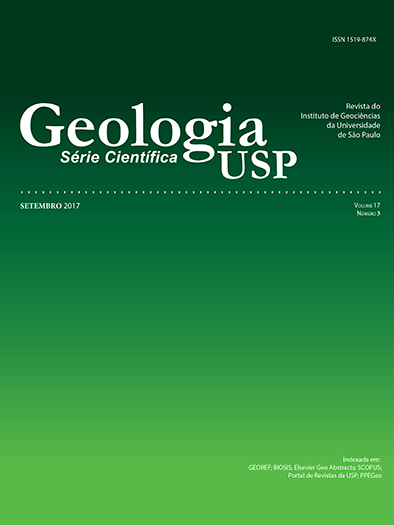Structural control of the southeastern border of the Parnaíba Basin, Northeastern Brazil: relationships with geodynamic events in Gondwana
DOI:
https://doi.org/10.11606/issn.2316-9095.v17-125909Keywords:
Parnaíba Basin, Southeastern border, Structural analysis.Abstract
Along the frontier between Piauí, Bahia and Pernambuco States (Northeast Brazil), the southeastern border of the Parnaíba Basin (BPar) is been mapped as a nonconformity between the Serra Grande Group (GSG) and the Precambrian basement. However, this border is characterized by an expressive NE trend parallel to the one of the Transbrasiliano Lineament, as well as a narrowing of the outcropping belt of the Silurian-devonian formations, as compared to the situation further north, in the east basin border. A swarm of NE-trending photolineaments was interpreted from remote sensing images. They occur very close (or coinciding) to the basin/basement limit or superimposed on the paleozoic units (especially the GSG and the Pimenteiras Formation). Supported by field data, three structural patterns were recognized and correlated to distinct deformation events. Dn deformation, of ediacaran-cambrian age and observed just in the Precambrian basement rocks, is related to a retrometamorphic, plastic-brittle late stage of Brasiliano mylonite zones. It is characterized by NE-trending dextral transcurrent shear zones, as well as quartz veins filling E-W extension joints. Dn+1 Deformation corresponds to a new stage of transcurrent dextral movement along the NE-trending structures, accompanied by normal faults and extension joints oriented WNW to E-W, in this case overprinting the Silurian-Devonian formations. Dn+2 Deformation is characterized by normal faults, basic dykes (correlated to the Eocretaceous Sardinha Suite), siliceous veins and ridges of silicified sandstones, all of them along the NE-SW trend. This last phase results from a NW-SE extension, analogous to the one recognized further east in the Interior Basins of Northeast Brazil, associated to the South Atlantic rifting.
Downloads
Downloads
Published
Issue
Section
License
Authors who publish in this journal shall comply with the following terms:
- Authors keep their copyright and grant to Geologia USP: Série Científica the right of first publication, with the paper under the Creative Commons BY-NC-SA license (summary of the license: https://creativecommons.org/licenses/by-nc-sa/4.0 | full text of the license: https://creativecommons.org/licenses/by-nc-sa/4.0/legalcode) that allows the non-commercial sharing of the paper and granting the proper copyrights of the first publication in this journal.
- Authors are authorized to take additional contracts separately, for non-exclusive distribution of the version of the paper published in this journal (publish in institutional repository or as a book chapter), granting the proper copyrights of first publication in this journal.
- Authors are allowed and encouraged to publish and distribute their paper online (in institutional repositories or their personal page) at any point before or during the editorial process, since this can generate productive changes as well as increase the impact and citation of the published paper (See The effect of Open Access and downloads on citation impact).





